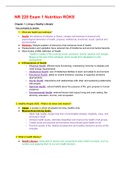NR 228 Exam 1 Nutrition ROKS
Chapter 1: Living a Healthy Lifestyle
Key concepts to review:
1.What are health and wellness ?
Health : the absence of disease or illness, merges and balances 6 physical and psychological dimension of health, physical, intellectual, emotional, social, spiritual and environmental. ●Wellness : lifestyle (pattern of behaviors) that enhances level of health. ●Pasteurization and sanitation have reduced risk of foodborne and environmental hazards.
●Rene Dubos (1968) Definition of Health
○“Health is quality of life involving social, emotional, mental, spiritual, and biologic fitness on the part of the individual, which results from adaptations to the environment.” ●6 Dimensions of Health
○Physical Health : efficient body functioning, maintaining immunity to disease and meet energy requirements
○Intellectual Health : use of intellectual abilities to learn and adapt to environment
○Emotional Health : ability to control emotions, express or suppress emotions appropriately. ○Social Health : interactions and relationships with other and sustaining relationship
with people. ○Spiritual Health : cultural beliefs about the purpose of life, give purpose to human existence. ○Environmental Health : external factors that impact living and work setting, like ethnicity, education, income, and occupation. 2. Healthy People 2020: What is its vision and mission?
●Vision : a society in which all people live long, healthy lives. ●Mission/Overarching Goals : ○Attain high quality, longer lives free of preventable disease, disability, injury, and premature death. ○Achieve health equity, eliminate disparities and improve the health of all groups. ○Create social and physical environments that promote good health for all.
○Promote quality of life, healthy development and healthy behaviors across all life changes. 3. What is health literacy?
●Health Literacy : being able to receive and comprehend basic health concepts, such as nutrition and applying them to our own health decision . ●Health literacy develops through education on topics related to health promotion and illness. ●Education Process of Health Literacy
○Formal Education : purposely planned for implementation in a school setting. ○Non-formal Education : organized teaching and learning events in hospitals, clinics, and community centers.
○Informal Education : variety of educational experiences that occur through daily activities, like watching TV, reading newspapers and magazines, browsing the internet or conversing with other people. ●Health Context : takes into account the influence of culture, social, and individual factors with developing health literacy. ○Cultural factors : ethnicity, religion, race
○Social factors : setting that members receive support or lack of support for health promoting behaviors
○Individual factors : choices we make on willingness to acquire then apply health knowledge. ●Health Literacy Actualization : being able to use acquired health knowledge and skills. 4. Name and define the multidimensional aspects of health.
●6 Dimensions of Health
○Physical Health : efficient body functioning, maintaining immunity to disease and meet energy requirements
○ Intellectual Health : use of intellectual abilities to learn and adapt to environment
○Emotional Health : ability to control emotions, express or suppress emotions appropriately. ○Social Health : interactions and relationships with other and sustaining relationship
with people. ○Spiritual Health : cultural beliefs about the purpose of life, give purpose to human existence. ○Environmental Health : external factors that impact living and work setting, like ethnicity, education, income, and occupation. 5. What are the 6 nutrient categories?
●Nutrition: how essential nutrients are processed and used by the body. ●Carbohydrates
●Proteins
●Lipids (fats)
●Vitamins
●Minerals
●water 6. What are essential nutrients and what are their functions?
●Essential Nutrients : essential because we can make some of it, but not enough so we get the rest through food. ○Carbohydrates : provide energy, help regulate body processes
■Source: glucose
○Proteins : provide energy, help regulate body processes, help aid growth and repair of body tissue. ■Source: amino acids
○Lipids (fats ) : provide energy, help regulate body processes, help aid growth and
repair of body tissue
■Source: linoleic acid, linolenic acid
○Vitamins : provides energy, but as indirect role as catalyst for body’s use of energy nutrients, help regulate body processes.
■Source: Fat soluble vitamins (vitamin A, D, E, & K). Water soluble vitamins (vitamin all Bs & C)
○Minerals : provides energy, but as indirect role as catalyst for body’s use of energy nutrients, help regulate body processes, help aid growth and repair of body tissue
○Water: help regulate body processes, help aid growth and repair of body tissue. ●Non-essential nutrients : made natural in body but also be absorbed from certain foods. Nutrition Facts Label.pdf (Links to an external site.)Links to an external site.
Water a Vital Nutrient.pdf (Links to an external site.)Links to an external site.
7. Nurses promote and increase the level of health for individuals, families, groups, and communities through the use of knowledge, different techniques and through community support. How do they do this?
●Through health promotion.
●Health Promotion : what we do to increase the level of healthy individuals, families, groups and communities. ●As nurses we do this through the use of: ○Knowledge
○Different techniques
○Enlisting support of community. 8. What are primary, secondary, and tertiary disease prevention behaviors and examples of each?
●Primary Prevention : initial treatment for prevention of a disease. Focus on promotion. ○Ex: immunization, low fat diet, high fiber (plant based) eating style.




